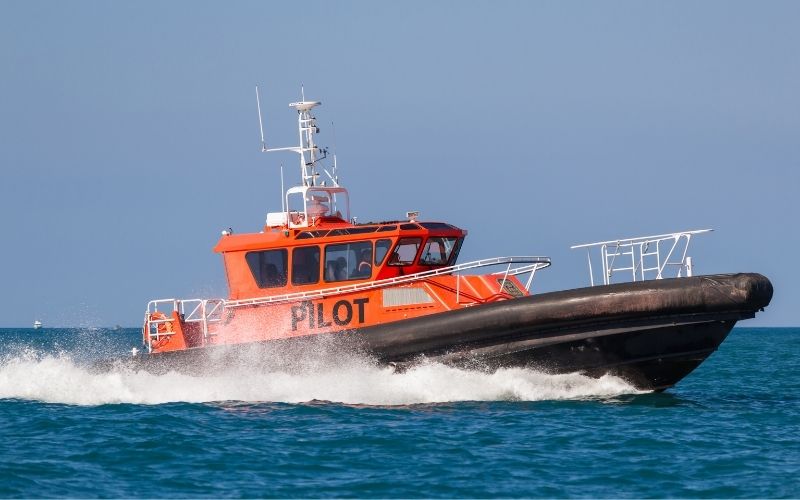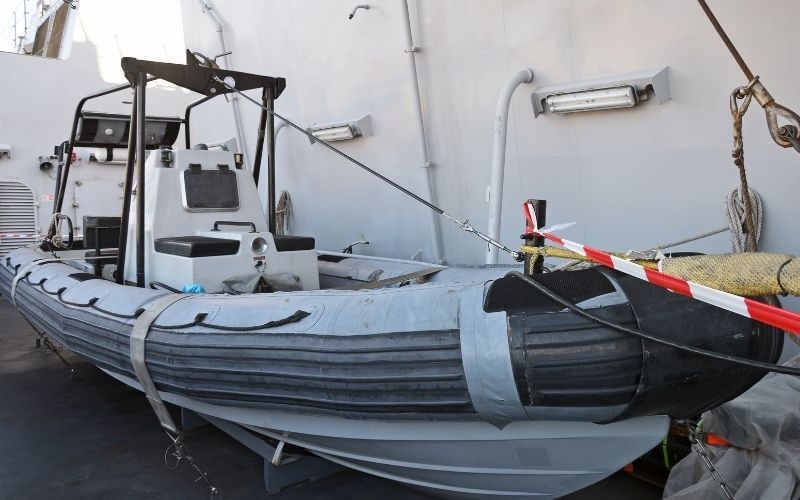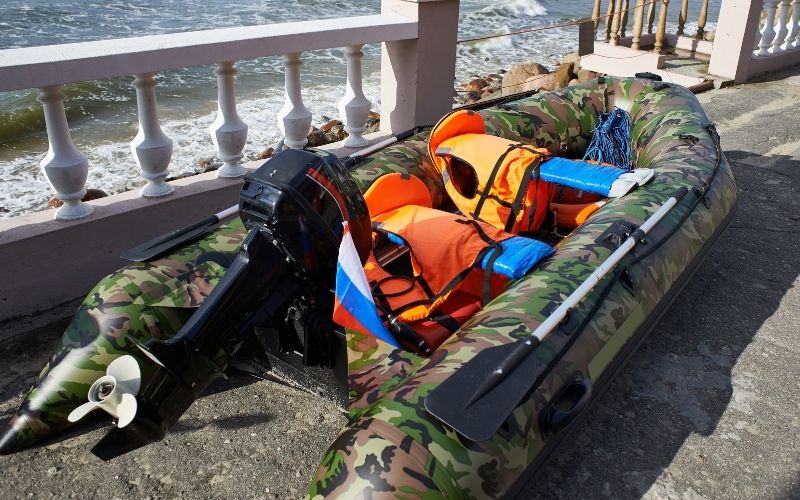Owning a RIB boat is one of the most fun experiences you can have. Compared to a regular inflatable dinghy, a RIB boat is safer and faster, especially in waves.
However, if you’ve never owned a RIB boat before, you may be wondering how to drive and operate it.
Luckily, driving a RIB boat is similar to driving a car. At first, it may seem intimidating. But, once you get the hang of it, it becomes second nature.
With that being said, you should always practice safe driving to prevent leaks or capsizing.
Driving a RIB boat comes down to starting the engine, learning how to navigate the steering handle, and always practicing safe driving.
In this article, we’ll tell you everything you need to know about how to drive a RIB boat.
Table of Contents
How Do You Start a RIB Boat?

Before you start the RIB boat, it’s important to understand that RIB boats operate through an outboard motor. This is essentially an engine attached to the back of the boat.
To move the boat, you have to start the motor and take the RIB boat through the water.
Some outboard motors can be turned on by pulling a handle, while others require turning a key.
Once the motor is turned on, you can drive the boat in the waters until you’re ready to stop.
Keep in mind; these are general guidelines for starting a boat. But you’ll want to check your RIB boat manual or outboard engine manual to learn everything you need to know about how to start and drive your boat.
Pulling the Handle
Here’s how to start the RIB boat if it has a handle.
First, you’ll need to plug in your kill switch. Essentially, it’s a safety device to protect you from accidents. (We’ll discuss more the kill switch in the safety section)
- Before starting the engine, you need to attach the kill switch clip to the motor.
- Turn the valve handles to the ‘choke’ setting. This blocks the air from entering the engine, meaning there will be a high fuel concentration, which helps the motor start.
- Make sure the gearshift is set to a neutral position. The neutral position prevents the boat from accelerating immediately when the boat moves.
- On the outboard engine, there’s a handle with a pull rope. Pull the rope back to start the engine. You may need to pull the cord three or four times to get the engine to fire up.
- To start moving the boat, there’s a handle you can pull down to move forward. You can stop the engine by setting it back to the neutral position. you push the handle up past the neutral setting if you want to reverse.
Turning the Engine Key
Electric start engines will use a key to ignite it.
- Tilt the engine down to ensure the propeller is in the water. This enables the fuel to flow inside the engine.
- Insert the key into the ignition to turn on and manually set the gearshift into a neutral setting.
- Turn the key to the “On” position or push the start button.
How Do You Drive a RIB in Waves?

Many RIB boats, especially ones with deep v-hulls, are designed to drive in waves easily. That’s because it’s designed to get onto the plane faster and ride the waves.
A shallower hull may experience more drag on waves, making it harder to maneuver.
Driving the boat will depend on the specific RIB boat you own. Most smaller RIB boats with outboard motors use a tiller handle to drive and steer the boat.
However, some may use a steering wheel. You can easily navigate the boat with the steering wheel like you would driving a car.
With a tiller, follow these tips to drive the boat:
- Adjust the lever forward or reverse to start moving the boat.
- Twist the boat’s tiller handle to accelerate or decelerate.
- Push and pull the tiller handle to steer the boat right or left.
Since waves vary, you’ll need to learn how to trim the boat. Trimming the boat means raising or lowering the bow of the boat. The trim is typically controlled by a toggle button located on the control lever.
To get on the plane and ride the wave, you’ll want to trim down. This means pushing the bow down and lifting the stern up to get up on the water.
Once you’re on the plane, you can trim up and raise the bow so that your RIB boat is skimming across the water rather than riding against the waves.
When you’re riding on the plane, the boat speed will increase, and the steering will feel lighter. This reduces drag and improves fuel efficiency.
How to Drive a Boat in Rough Weather?
Rough weather can put boats in danger because it can cloud the captain’s vision and cause heavy waves. As a general rule, you should always be looking to head back to shore and dock your boat in bad weather.
First, you’ll want to slow down your boat. Traveling at high speeds in rough waves can lead to broaching.
Broaching happens when the vessel travels too fast over the crest of a wave, which causes the bow to submerge in the following wave. When the bow is submerged, the captain can lose control and veer off-course.
Next, you want to approach the waves at an angle and not head-on. Approaching them at an angle, especially on its long axis, will decrease the force exerted on the boat from rolling waves.
Most RIB boats have an automatic bilge pump, which should automatically get the water out. If there isn’t, you should have a passenger bail out excess water.
Safety Tips for Driving a RIB Boat
Before you even move to drive your RIB boat, you should follow these safety tips to prevent any accidents. First, you want to understand what a boat engine cut-off switch or ECOS is.
Cut-Off or Kill Switch

Boat personal watercraft and outboard-powered boats must have these cut-off switch devices. A kill switch is a safety device that immediately shuts off the outboard engine if the driver moves away from the boat’s controls. It works by breaking the electrical circuit to the outboard motor, which prevents the engine from running.
There are two types of kill switches: a tethered and an electronic version.
The tethered version is when a C-shaped clip is attached to the kill-switch button at the helm station. Also, the clip is attached to a lanyard, which will also be hooked onto you (the driver).
If the driver moves away from the help, the clip will automatically unlock from the spring-loaded button, turn off the engine, and stop the propellers.
Some owners may prefer an electronic cut-off switch by wearing a bracelet. These digital switches communicate to the boat engine wirelessly and trigger the action by proximity.
Many boat owners may prefer a digital kill switch since it won’t restrict their movement the way a physical lanyard would.
Carry Your Boat Across the Beach

Since most RIB boats are small, it’s common for owners to drag them across the beach.
Any rocks or sharp objects on the ground can easily scuff, scratch, or even puncture the boat’s hull.
Although your boat may be tough, there’s no reason to damage your boat unnecessarily.
Protect your boat and prevent accidents by carrying your boat until you reach the waters.
Inspect Your Boat Before Leaving
Before you even get into the boat and start driving, you always want to inspect your vessel for any problems.
Spotting a problem ahead of time will prevent a disaster from waiting to happen. For example, if there’s a tear in the material, it could cause leaks and sink the entire boat.
Here is a pre-launch checklist you can follow:
- Inspect the transom and hull for damage, leaks, or tears.
- Remove all debris or fishing lines from the prop shaft and propeller.
- Check the fuel links for any leaks.
- Make sure all electrical connections are secure and that the battery is fully charged.
- Ensure all instrumentation, gauges, and navigation lights are working properly.
- Make sure the drain plug is secure.
Bring Safety Gear on Board

Although you can plan everything out and perform all the safety checks, accidents can still happen. Perhaps, your boat hits a rock, or another unforeseen accident occurs. Bring these safety items on board just in case:
- Personal floatation devices for you and everyone onboard
- Repair kit
- Oars
- First aid kit
- Flashlight
- Fire suppressant equipment
- Signal equipment such as flares, whistles, and mirrors
Conclusion
Once you get into the boating lifestyle, you’ll love taking yourself and your family on water excursions!
It may take a little bit of practice to get good at driving your RIB boat. But don’t worry, this is a guide you can always reference back to.
This comprehensive blog post should give you a good understanding of how boat driving works and what to expect.
Now give it a shot and let us know how your first trip goes!

I created this site to help people – to help you – with your boat problems. Instead of helping one person at a time, I want this website to be the “one-stop-shop” for everyone’s boating concerns. Read more.

